
Site Contents
About Us
Contact Us
Events
Products
Scythe Buyers' Guide
Technical/
Instructional
Updates
Video
Home
The "Maximum Sustainability, Maximum Soul,
and Best Ergonomy Snath"*



*This term was coined by Henrik Jørgensen of Denmark in the course of our written exchange of thoughts on the topic of snath design. By it he refers to the versions of snath we have been learning about, making, and experimenting with for nearly 15 years.
Poets or philosophers could indeed write volumes on the relationships of "sustainability", "soul" and ergonomics. Being neither, I will attempt to sum up the essence below:
- The material for the most sustainable snath is obtained locally, preferably within walking distance of where the maker lives.
- No living tree is cut specifically for its making. The wood is a by-product of the cutting of firewood (preferably dead or dying trees), the thinning of young dense growth, roadside maintenance, or other forms of "necessary" forest management.
- The wood is obtained and processed into a tool handle without the need for fossil fuels or industrial infrastructure. Only human-powered tools (hand saw, hatchet/ax, drawknife, brace and bit) are employed. Using dimension-sawn lumber as raw material requires an altogether different process - trees are trucked to the sawmill, cut into planks and trucked again, often over great distances - a fossil-energy-intensive route.
- An ergonomic snath should fit "like a glove". It is an extension of the hands... Once you try a truly ergonomic tool of any kind, you simply would not be satisfied with the oft-accepted standard.
- The soul element concerns association, memories and feelings. After making many dozens of snath I still remember, for instance, where exactly in the forest I obtained the wood for my first one 15 years ago. I gave away the snath long ago, but closing my eyes for a moment I can still feel that very one in my hands. As when picking and eating a life-sustaining fruit, we can feel the appreciation for Nature's gifts, far more than if we purchase things with money.
- A soul snath should not have the appearance of a plain homogeneous piece of wood. It should have some natural character, perhaps some inner or outer bark left on. "Blemishes" like knots, cracks or spalted wood add more than an aesthetic touch; they are statements that a fully functional tool can often be made of less than the prime material. We can live and work happily while demanding less and conserving more.
- Fashioning it, from start to finish, considering the details of preferred shapes and personalized fit, naturally imbues the snath with soul. If I am making one for a specific person, that person is on my mind during the process - and a bit of the soul is transferred...
- The innate soul of a snath exists in the wood when it is growing as a tree; nearly every branch or sapling already has the potential to become a snath, almost regardless of its shape or species. It could, of course, become many other things - a wooden beam in a house, paper for a book, a dollar bill or phone bill, toilet paper, or a match to light a fire; or a handful of humus, the final destination of all organic matter. To create a snath from a piece of wood respects it as a fragment of the tree's soul. The sweat of the hands, the dew, rain and sunshine all add to its soul.
I have on this website made numerous references to the "ergonomy" of a snath (scythe handle) and criticized most designs for the lack of it. The partial explanations of what I mean by better design, starting with the diagrams and text of The Scythe Must Dance, have been scattered in various places rather than presented in a concise and conveniently-read piece. The material in this section is by no means a complete picture on the subject; not only because the concept of ergonomy as applied to various tools continues to evolve, but because we simply have not found the necessary time and energy to share what we have learned thus far. An entire book (not a booklet) could be written on the topic of creative snath-making, and though it would be my pleasure to write one or help someone else do it, presently the important tasks are too many and the hours too few. Until then, we will address the subject in a partial but hopefully more useful/comprehensive way than up to now.
I have been told - over and over again - that our culture is increasingly impatient, and attention spans keep growing shorter; that people want to first see the end result before reading detailed instructions of how to get there, that beginners want to mow grass before hearing an explanation of how to sharpen a blade so it "cuts with ease". Complying, though reluctantly, with these modern desires, we will show first a variety of ergonomic snaths.
As different as they are from each other, all are examples of design principles which take the user's comfort - rather than economy of manufacture - into consideration. The late David Pye (author of The Nature and Aesthetics of Design and The Nature and Art of Workmanship) would certainly have referred to all of them as products of "workmanship of risk" and as a lifelong craftsman would endorse the results.
Risky or not, much can be said in favour of carefully making the handle of a tool one intends to spend many hours using. Provided the maker understands the principles involved, these snaths can function better than those produced by Pye's definition of "workmanship of certainty". Fine points often considered cost-prohibitive in volume production can be incorporated into the design. Handcrafting a snath gives one an opportunity to imbue it with personality, and the result is what Henrik Jørgensen referred to above.
With respect to the strength needed for sensible use, nearly all commercially-produced traditional (wooden) snaths are "overbuilt". Because of the "safety margin attitude", they are designed to take the highest level of predicted stress; and so it is that a farm woman carefully trimming the grass around her flower beds with a light 60-cm blade uses the same snath as her husband would take to a mowing competition, where he will cut at each swing all that a 120-140 cm blade is capable of - which may be ten times the stress or more. I am not making this up; it is an actual example from Switzerland, the country where more different wooden snath models are still manufactured than likely anywhere else. Yet all are regional specimens built in one size and one weight, with respective stores generally carrying only one model.
The length/weight of blade to be mounted on a particular snath or its intended specific use has apparently not been given much consideration. Why, for example, are the heavy bush blades used on the same snaths as the light grass blades? To me this makes no sense, other than that it may be expedient for the makers and/or the sellers.
Well, an individual who puts ergonomy ahead of expediency can afford to do all sorts of things that a "professional" cannot, i.e. relatively easily work with shapes, balance, and various species of wood. That is precisely what I have been doing, and it has been a fascinating process.
The photos in this section represent only a fraction of the results.
Click each for a full-size image.
Some of my earlier homemade snaths (1998-2001).
Fig. 1
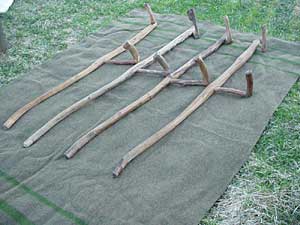
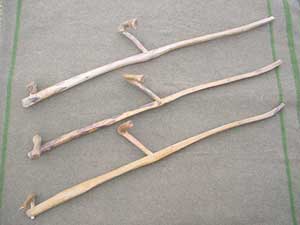
For serious mowing with long blades, I prefer my more
recently-created models; a few examples below:
Fig. 2
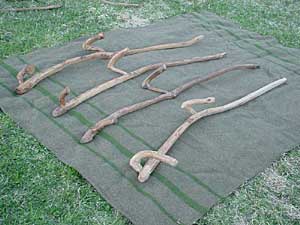
Fig. 3
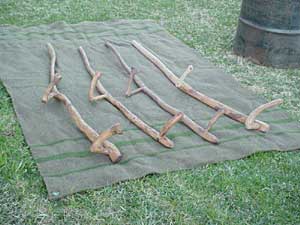
More of the same with blades mounted.
Fig. 4
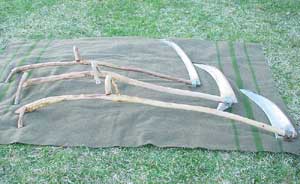
Fig. 5
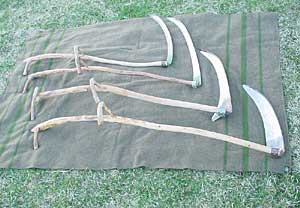
A bit of trivia--below are the two scythes that Kai and Fairlight used at the mowing competition in Truro, Nova Scotia in 2005. Kai's is a more normal "farmer's scythe" with an 80cm/32" blade. Fairlight won, despite her smaller size, partly due to a longer (100cm/39") blade and a snath designed for competition use.
Both snaths are made of the same "inferior" wood--the alder species common in this area (Alnus incana).
Fig. 6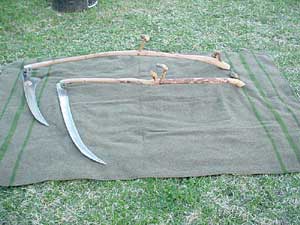
Fig. 7
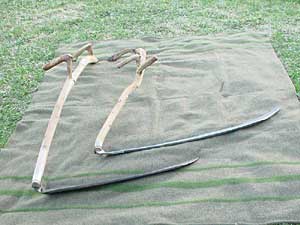
Fig. 8
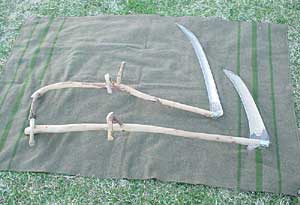
Below is a non-professional photo gallery of various snaths and grips. Scroll down or click here to read more.
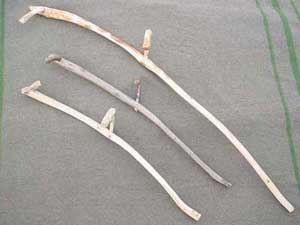
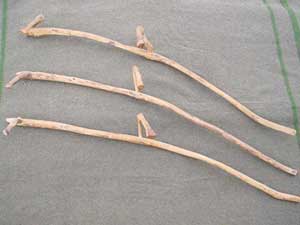
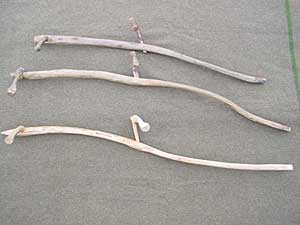

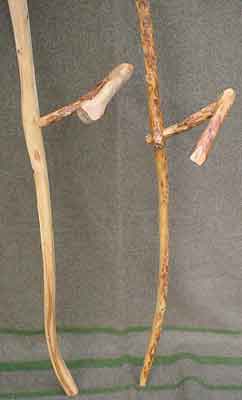
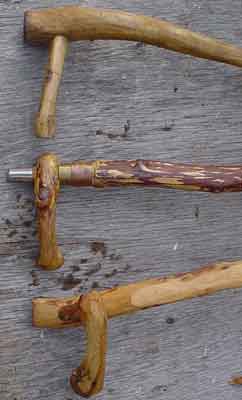

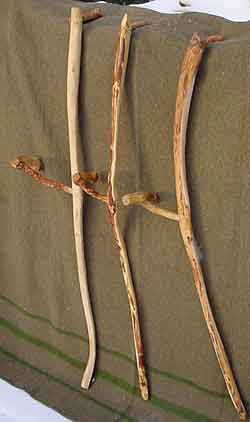
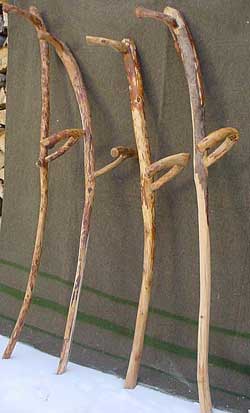
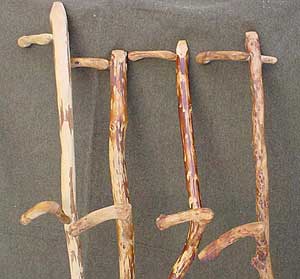
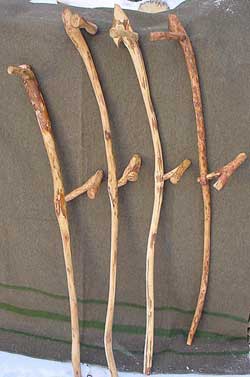
The images above may raise the question, "Which of those models is the best? Does one of those photos show the "perfect" snath?" The point here is to show a variety of ergonomic snaths rather than a "perfect" one. I do not claim to have made such a specimen, nor for that matter, am I trying to do so. Rather, by experimenting, I am learning about the range of "acceptable" design.
Apart from the weight distribution on the snath body, many other features enter the ergonomy equation. One of them is the overall shape; i.e. the oft-argued question of straight versus curved snath. David Tresemer declared the straight wooden model his company made "a grander snath than any other" because it "permits full use of the blade's virtues in a balanced swing". I do not agree with the first portion of that statement (and have not yet determined what he meant by the second). Not necessarily because I think that a grand snath must be curved, though I do like curves if they are in the "right" places.
In Fig. 11 and Fig. 12 are snaths which I consider to have nearly the ideal side-view profile. They all feature a "double curve", some more distinct than others.
 |
 |
It could be said that the curve near the upper end of the snath accommodates the user, and the curve near the bottom accommodates the blade. In other words, the upper curve provides the human body with more comfort than a snath in which the upper half is straight, and the bottom curve allows many blade models with relatively low-angle tangs to travel along the ground in the desired position while the mower stands comfortably upright. However:
1. Both curves can be overdone, i.e. represent "too much of a good thing".
2. Under certain conditions, both curves can be eliminated without undue disadvantage.
3. The upper curve's ergonomic advantage diminishes if the scythe is used exclusively or predominantly on very steep terrain, or in a very low-to-the-ground mowing stance.
4. For blade models with steep tangs, the lower curve is not only unnecessary, it prevents a good fit. That curve may also be undesirable for a shorter person mowing in a wide stance using a blade with the average tang angle (about 25 degrees).
From the points made so far, it should already be evident that an ergonomic snath is not simply of one fixed "magical" shape.
20 May 2006
Modified 01 Jan. 2010